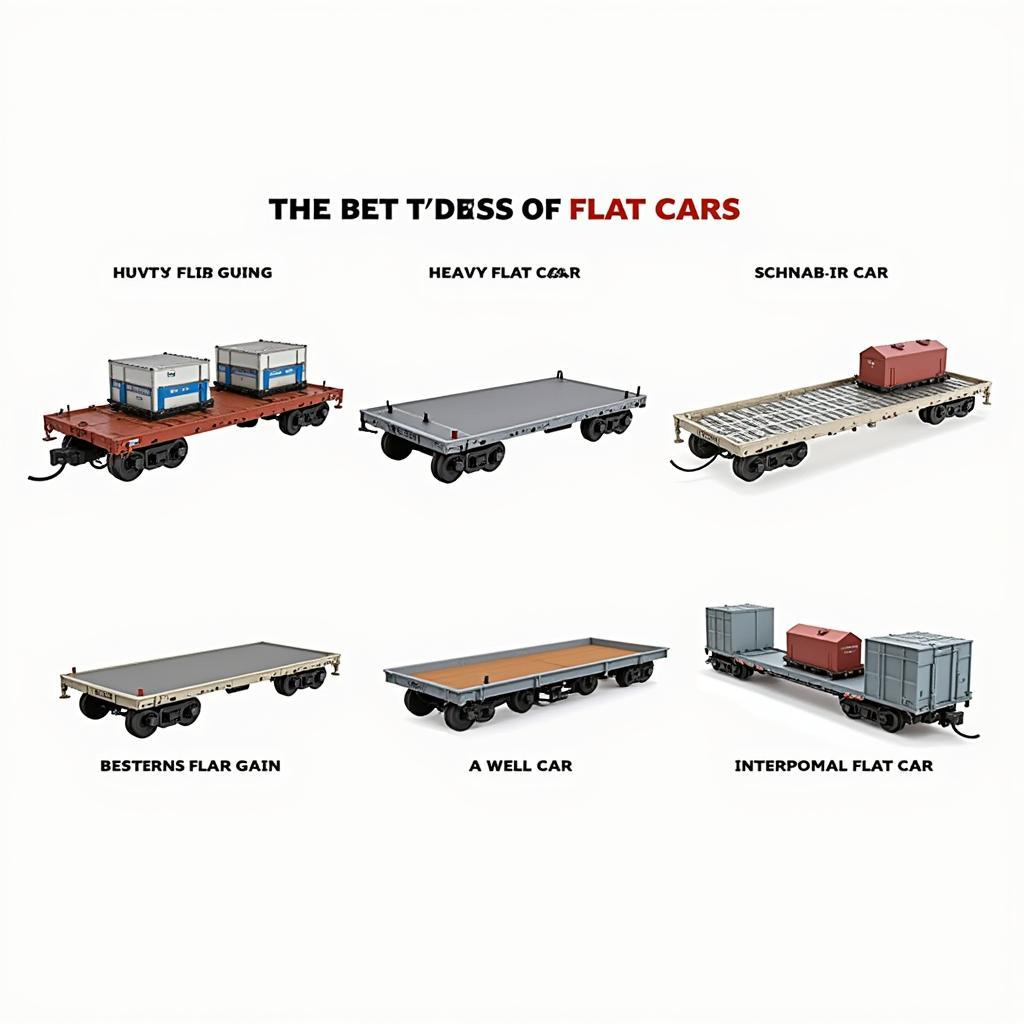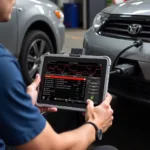A flat car is a type of railroad car that is characterized by its flat deck and lack of sides or a roof. This simple design makes it incredibly versatile for transporting a wide variety of goods. From lumber and steel to vehicles and heavy machinery, the flat car plays a crucial role in modern logistics. Let’s delve into the world of flat cars, exploring their various types, uses, and significance in the transportation industry. If you’re interested in car accessories, check out our guide on the best car tire inflator.
Different Types of Flat Cars
Flat cars come in various configurations to accommodate different cargo needs. Understanding these distinctions is key to maximizing their utility.
Basic Flat Cars
The most common type is the basic flat car, a simple platform on wheels. These are ideal for transporting large, uniformly shaped items like lumber, steel coils, and concrete pipes. They are cost-effective and readily available, making them a popular choice for many shipping needs.
Specialized Flat Cars
Beyond the basic design, specialized flat cars cater to more specific cargo requirements. These include:
- Heavy-duty flat cars: Designed for extremely heavy loads like transformers and industrial equipment. These feature reinforced decks and stronger wheel assemblies.
- Schnabel cars: Used for transporting exceptionally large and heavy objects that cannot be easily disassembled. The cargo is suspended between two pivoting arms, distributing the weight evenly.
- Well cars: These flat cars have a lowered central section or “well” to accommodate taller cargo that would otherwise exceed railway clearance limits. They are often used for transporting large vehicles or pre-assembled sections of bridges.
- Intermodal flat cars: Specifically designed for carrying intermodal containers, these are essential for efficient transfer between different modes of transport like ships, trains, and trucks.
Imagine needing to transport a massive wind turbine blade across the country. A standard flat car wouldn’t be suitable. This is where specialized flat cars, like the Schnabel car, become indispensable.
Why Choose a Flat Car?
Flat cars offer numerous advantages in the transportation landscape:
- Versatility: Their adaptable design allows them to accommodate a wide range of cargo sizes and shapes.
- Cost-effectiveness: For large, bulky items, flat car transport can be more economical than trucking, especially over long distances.
- Efficiency: Flat cars can be easily integrated into intermodal transportation systems, streamlining the movement of goods between different modes of transport.
- Heavy-duty capacity: Specialized flat cars can handle exceptionally heavy loads that would be impossible for other transport methods.
Loading and Securing Cargo on a Flat Car
Proper loading and securing of cargo are critical for safe and efficient transport. This involves careful planning and the use of specialized equipment:
- Assessment: Determine the cargo’s dimensions, weight, and center of gravity.
- Selection: Choose the appropriate type of flat car based on the cargo’s characteristics.
- Loading: Use cranes, forklifts, or other specialized equipment to load the cargo securely onto the flat car.
- Securing: Employ chains, straps, and other tie-down methods to prevent shifting or movement during transit.
- Inspection: Thoroughly inspect the secured cargo before transport to ensure stability and compliance with safety regulations.
You might be interested in our article on flat bed car trailer with whinch, which discusses similar principles of loading and securing cargo.
The Future of Flat Cars
The role of flat cars is evolving with technological advancements. Innovations like automated loading systems and real-time tracking are improving efficiency and safety. Furthermore, the increasing emphasis on intermodal transportation is driving the development of more specialized flat car designs optimized for container handling. These developments highlight the continued importance of flat cars in the future of logistics. Do you need a comfortable resting option during long journeys? Check out our review of inflatable in car bed.
For those looking for car rentals in Montana, you can explore our guide on car rental Kalispell mt.
Conclusion
The flat car, in its various forms, remains a vital component of the global transportation network. Its versatility, cost-effectiveness, and ability to handle heavy loads make it an essential tool for moving goods efficiently. As technology continues to advance, the flat car will undoubtedly play an even more significant role in shaping the future of logistics. Considering a fun road trip? See our post about romantic guy and girl selfie car for inspiration.
FAQs
- What is the maximum weight a flat car can carry?
- What types of goods are typically transported on flat cars?
- How are goods secured on a flat car?
- What are the advantages of using flat cars for transportation?
- What is the difference between a flat car and a gondola car?
- How are flat cars used in intermodal transportation?
- What are the future trends in flat car design and technology?
Further Questions & Related Articles
- How are flat cars maintained and inspected?
- What are the safety regulations for transporting goods on flat cars?
- What are the environmental impacts of using flat cars for transportation?
For any assistance, please contact us via WhatsApp: +1(641)206-8880, Email: cardiagtechworkshop@gmail.com Or visit us at: 276 Reock St, City of Orange, NJ 07050, United States. We have a 24/7 customer support team.



